What Is Fissure-in-ano?
Anal fissure or fissure-in-ano is one of the most common causes of anal pain and bleeding from the anus. Precisely, fissure-in-ano is a small cut or tear in the mucosa (lining) of the anus due to friction, scratch, or trauma.
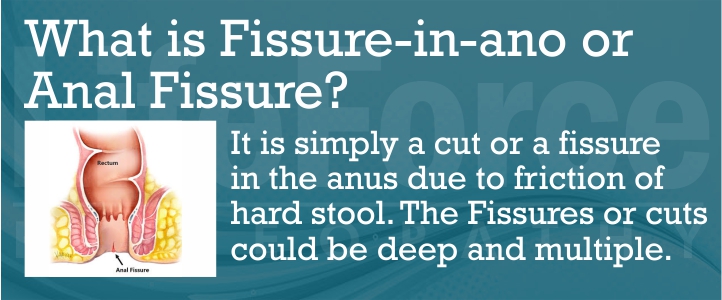
In most patients, pain is intolerable and may be disproportionate to the severity of the lesion (fissure). Some patients describe the pain as passing pieces of broken glass while passing stools and a burning pain, which remains for several hours after passing stools. A few patients often report that the pain is so severe that they avoid defecation due to the fear of severe pain. This further leads to the hardening of the stools, which further tears the lining of the anus during the next defecation, setting a vicious cycle. Fissure-in-ano can significantly affect the quality of life of the patient.
Chronic conditions, such as long-standing constipation, diarrhea, Irritable Bowel Syndrome, frequent use of laxatives, and post-pregnancy, are some of the most common causes of fissure-in-ano.
The presentation of a fissure-in-ano could be acute or superficial (symptoms lasting for less than 6 weeks), chronic fissure (symptoms affecting more than 6 weeks), or recurrent.
Fissure-in-ano is a common gastrointestinal disorder seen in highly professional individuals, drivers, kids with poor diets, and females during and post-pregnancy. It is a painful and troubling condition that can grossly affect one’s quality of life.
Fissure-in-ano can be acute (lasting for 4-6 weeks). An acute fissure looks like a fresh paper cut and is usually superficial and easier to heal. A chronic fissure lasts for more than 8 weeks and the cut is deeper accompanied by internal or external lumps or fleshy growths. This takes a long time to heal. There are recurrent fissures that need intermittent treatment
Homeopathic Treatment For Fissure-In-Ano:
As per our experience at Life Force, Homeopathy is highly effective and recommended in treating all forms of Fissure-in-ano. It is possible to avoid surgery in many cases of Fissure-in-ano if homeopathic treatment is administered at the proper time. As per our experience in treating different causes of Fissure-in-ano, in over 80% of cases, homeopathic treatment has proved effective.
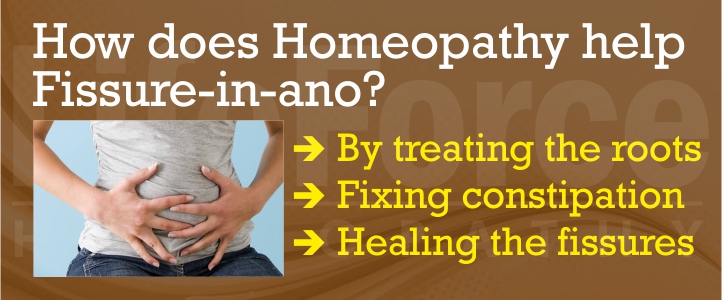
How homeopathy can help in a fissure-in-ano?
- Homeopathic treatment is based on an individualized case study and a detailed evaluation of the case. During the homeopathic case study, presenting symptoms, causation of the anal fissure, past medical history of the patient, family history, patient’s lifestyle, mental state of the patient, and present and past treatment are taken into consideration. Hence, homeopathic medicines selected after this correct the root cause of the disease and heal the disease at a deep level.
- Homeopathic medicines facilitate healing and improve blood circulation to the anal mucosa. It also relieves you of the anal spasm and gives relief to the pain.
- Homeopathic medicines correct the underlying disturbed digestive system, such as the tendency for chronic constipation.
- The results obtained with homeopathic treatment are long-lasting.
- It is possible to avoid surgery in many cases of Fissure-in-ano if homeopathic treatment is administered at the proper time.
- If needed, initially, homeopathic treatment can be taken in association with symptomatic conventional medication.
- Homeopathic treatment is completely safe, harmless, highly effective, and non-toxic.
- Homeopathic medicines are non-habit-forming.
Homeopathy should be thought of as the first line of treatment for Fissure-in-ano. It aims at treating the underlying cause along with relieving the symptoms. Homeopathic medicines not only help in healing the tear but also treat constipation by making the stools soft. It stimulates the sluggish digestion and peristalsis of the intestine. Homeopathic medicines also help reduce the tendency to get fissures, which means the recurrence of fissures can be avoided through a systematic treatment protocol. During treatment, the frequency, duration, and intensity of symptoms like pain, bleeding, and constipation are measured. Since the physical examination is not always feasible, this method gives an idea about how well the fissure has healed. Homeopathy is by far the safest mode of treatment to treat fissures. The medicines are completely safe, non-habit forming, non-toxic, and do not have side effects even after consuming them for a long time.
Duration of treatment
Through our experience at Life Force, acute fissures usually take 6 to 8 months to heal. However, the time taken to heal varies from one individual to another. Chronic fissure takes a long time to heal. These cases respond within the first 6 months of initiating the treatment and patients get relief in regards to symptoms like pain and bleeding. Intermittent treatment to prevent the recurrence of the fissure might be needed in some cases.
Supportive management of Fissure-in-ano (diet, lifestyle, and home remedies)
The key to treating Fissure-in-ano is not to strain at stool. Visit the toilet only when you have the urge. Be physically active and follow a healthy lifestyle to avoid constipation. What you eat throughout the day is important.
Diet regimen
Eat homemade fresh meals. Have adequate liquids throughout the day. In case of constipation, eat fiber-rich food like cereals, millet, and oats. Eat fruits like papaya, guava, and bananas empty stomach on a daily basis. Avoid too much spicy food, coffee, tea, and aerated drinks. In case of diarrhea, treat it well within time by treating the cause. In such cases, avoid fiber-rich food and switch to soft, semi-solid lightly spiced, nutritionally dense foods like thick vegetable soups, dal rice with sabzi, millet porridge, idli, dosas, poha, upma, etc. Avoid alcohol and heavy meals like bakery goods, and deep-fried and non-vegetarian foods, especially after 7 pm.
Home remedies
Sitz bath: This is an age-old well-proven method followed to treat Fissure-in-ano. It helps in relieving the spasm of the anal sphincter and thereby symptoms of itching, pain, and bleeding. It also supports healing if practiced daily for 10 minutes for a period of a few weeks depending upon the severity of symptoms. Sit in tub warm water in a tub at hip level. Try to contract and relax the anal sphincter. This process helps to strengthen the anal sphincter and improve the anal muscular tone. Indirectly it also helps relieve constipation.
Maintain hygiene in and around the anal area.
Apply Vaseline (petroleum jelly) locally to the anus
Duration of homeopathic treatment:
Most patients show a significant improvement in about 4-6 weeks. The total duration of the homeopathic treatment varies from patient to patient. The duration of the treatment depends on the following factors:
- The duration of suffering: when the patient is suffering from a Fissure-in-ano
- Type of Fissure-in-ano: Acute, chronic, or recurrent
- Cause of Fissure-in-ano
- The lifestyle of the patient
- Underlying disease condition (chronic constipation, IBS, Ulcerative colitis, Crohn’s disease, etc.)
- The general health of the patient
- Dependency on laxatives or other conventional treatment
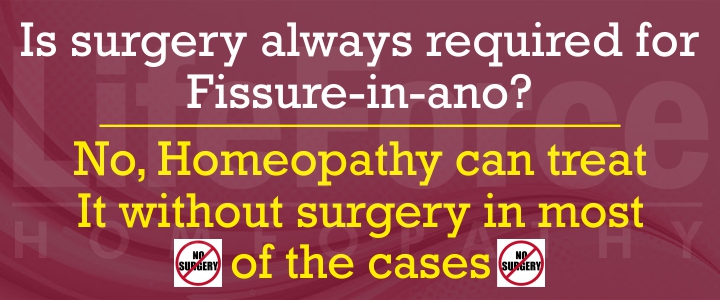
What are the chances of recovery from a fissure-in-ano with homeopathy?
- Excellent result: Excellent results can be seen in early and mild cases of Fissure-in-ano.
- Good Result: One can expect a good result in 2-3-year-old cases of Fissure-in-ano to a moderate extent.
- Not-so-good result: Very severe cases with large fissures persisting for a long time may not show a good result or may not respond at all.
Commonly prescribed homeopathic medicines in a fissure-in-ano:
Some of the commonly prescribed homeopathic medicines for Fissure-in-ano are Graphites, Ratanhia, Nitric acid, Paeonia, Sulphur, Silicia, Natrum Muriaticum, etc.
What Happens In Fissure-In-Ano? (Pathogenesis)
An anal fissure is a small cut or a tear in the mucosa (lining) of the anus due to friction, scratch, or trauma.
Chronic conditions, such as long-standing constipation, diarrhea, Irritable Bowel Syndrome, frequent use of laxatives, and post-pregnancy, are some of the most common causes of fissure-in-ano.
The cut or tear in the anal mucosa causes severe pain leading to an anal sphincter spasm and increasing the anal sphincter muscle pressure. This results in a decrease in blood flow to the site of the injury. Decreased blood flow affects or interrupts wound healing. Due to this, further bowel movements or passing stools result in more pain and anal spasm. This again leads to diminished blood flow to the area and the vicious cycle continues.

Fissure-in-ano may be acute (recent onset and short-lasting) or chronic (lasting more than 6 weeks). Acute cases of the Fissure-in-ano appear as a simple tear in the anal mucosa. Chronic fissures may present with swelling and scar tissues along with the tear. It may also present an external lump called a sentinel pile or skin tag. A few cases of chronic Fissure-in-ano may show an extra tissue inside the anal canal called a hypertrophied papilla.
The process behind the formation of the fissure can be very notorious. At times, it can surprise anyone without any specific cause. But the most common reason behind the painful cut is constant friction, rubbing, and straining in a particular area of the anal canal.
The vicious cycle of the formation of Fissure-in-ano
Chronic long-standing constipation or chronic diarrhea? frequent rubbing, friction, or trauma in the inner lining of the anal mucosa? cut or tear in the inner lining of anal mucosa (painful Fissure-in-ano) ? fear or anxiety due to pain leads to avoidance or postponing or holding back of stools? chronic constipation? long, hard stools cause straining during defecation? Fissure-in-ano increases? more fear and avoidance during defecation (habitual constipation)? anal sphincter spasm? sluggish (slow) or less blood circulation around the anal canal? delayed wound healing
Prevalence Of Fissure-In-Ano :
Fissure-in-ano can occur at any age. Infants and kids who are bottle-fed with a poor diet can also suffer from this disorder. It affects both males and females equally.
Causes Of Fissure-In-Ano:
Factors that may lead to trauma or tear in anal mucosa are listed below.
- Constipation: Constipation is one of the common causes of fissure-in-ano. Chronic constipation, such as habitual constipation, drug-induced constipation, or constipation due to pregnancy, leads to abrasion or forceful rubbing of the anal mucosa leading to a fissure. Untreated or neglected constipation is the main culprit that does all the harm to the anal canal over time. Constipation due to sluggish bowel movements is by far the most common cause of Fissure-in-ano. Hard stools lead to straining and difficulty in passing out the fecal matter. This process causes friction, trauma, and sluggish blood circulation in and around the anus (lower part of the rectum). When this occurs frequently it leads to the formation of a cut in the friction area thereby leading to Fissure-in-ano. Constipation can be habitual, medicine-induced, or laxative-dependent.
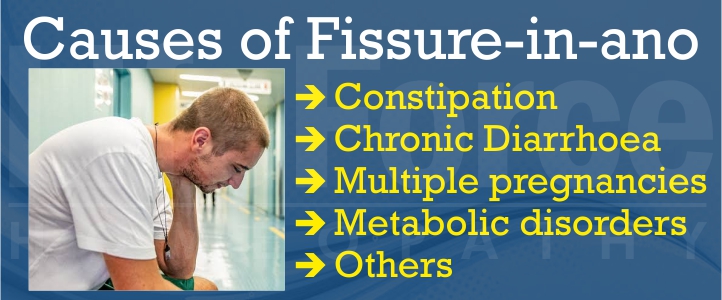
Factors such as sedentary lifestyles, defective dietary habits, faulty eating habits, stress, etc. may also lead to constipation.
- Diarrhea: The bout of forceful diarrhea leading to passing bulky stools very quickly, particularly in children, can cause injury to anal mucosa, resulting in a fissure.
- Multiple pregnancies: During pregnancy or childbirth women may develop anal fissures due to recurrent straining during labor
- Chronic use of laxatives: Laxatives or purgatives are habit-forming. Using laxatives for a long time and then stopping their use may cause more constipation. Constipation may further lead to fissure.
- Underlying other diseases: Fissure may be a manifestation of an underlying disease, such as Crohn's disease, ulcerative colitis, irritable bowel syndrome, sexually transmitted disease, tuberculosis, cancer, etc.
- Sedentary lifestyle (sitting for long hours): This cause is most commonly seen in type A personalities who tend to sit for long hours without taking a break from work. Drivers are also affected due to a similar cause. The long sitting hours lead to sluggish blood circulation towards the rectal muscles. Continuing the same lifestyle for years together leads to the loss of muscle tone of the anal muscles. Lessor no activity further adds to slow gut movement (peristalsis) thereby leading to constipation and formation of hard stools. The frequent straining at stools and constant friction and loss of muscular tone cause a cut and pain in the anal mucosa that increases with time.
- Trauma: Trauma to the anal mucosa due to hard stools or anal intercourse is also one of the causes of fissures that many patients hesitate to narrate during case history.
- Straining during labor: Postpartum Fissure-in-ano is a common problem that many females face after childbirth. Due to long hours of straining during labor pressure on the anal sphincter causes tears in the anal mucosa. Most of the tears heal within a few days or months without needing rigorous treatment. If left untreated, they might get chronic and might be difficult to heal.
Symptoms Of Fissure-In-Ano:
Commonly presenting symptoms of a Fissure-in-ano:
- Severe pain while passing stools
- The patient may experience pain as if passing pieces of broken glass or severe knife-like pain while passing the stools.
- Some may experience severe burning pain, which remains for several hours after passing the stools.
- A few patients often report that the pain is so severe that they prefer to avoid defecation to avoid pain.
- Sometimes, there is persistent dull pain before and for hours after passing the stools.
- Severe spasm of the anal sphincter
- Streaks of blood with stools or on the toilet paper
- Itching at the anal region
- Swelling at the anal region
- Discharge from the anus
- A small lump or a skin tag near the anal fissure
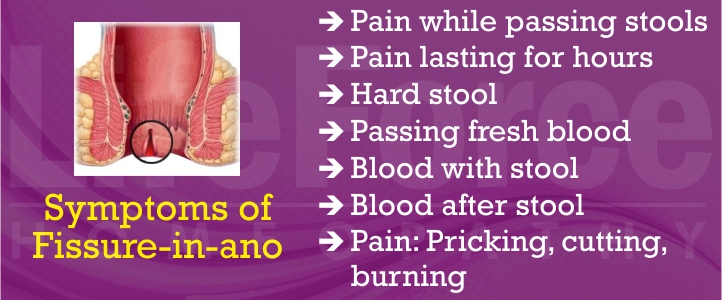
Diagnosis Of Fissure-In-Ano:
The diagnosis of a Fissure-in-ano is done by the evaluation of medical history and clinical examination. The doctor may examine the anal canal and rectum to confirm the diagnosis. The doctor may use anoscope for the local examination. An acute anal fissure may look like a superficial fresh tear. A chronic fissure may be a deeper tear and may have internal or external fleshy growth.
The doctor may advise sigmoidoscopy or colonoscopy in some cases to rule out other disease conditions affecting the rectum and anal canal.
Supportive Treatment (Diet, Lifestyle, and Exercises) For Fissure-In-Ano:
Along with proper medication, some supportive measures help in overall recovery from the Fissure-in-ano. They are listed below
- Eat a healthy diet: In most cases of Fissure-in-ano, constipation is the underlying cause. To avoid constipation, eat more fruits, green vegetables, cereals, whole grains, etc. Avoid deep-fried, oily, bakery products, alcohol, coffee, etc. from the diet. Drink at least 8 glasses (12 cups) of water a day.
- Avoid using aluminum vessels for cooking any food. Long-term use of aluminum may lead to poisoning, leading to constipation.
- Laxatives or purgatives are habit-forming. When you use a laxative for a long time and once you stop using them, it may lead to more severe constipation.
- Use warm baths or Sitz baths, which may help to relieve the pain and promote healing. (Use 8 inches of warm water in the bathtub 2 or 3 times a day for 5-10 minutes.) Do not use very hot water.
- Exercise regularly: Regular exercise helps to avoid constipation.
- Do not suppress the desire of passing stools, as this may result in hard and large stools and cause injury to the anal mucosa. Avoid straining at stools.
- Keep the anal area clean and dry to avoid infection.
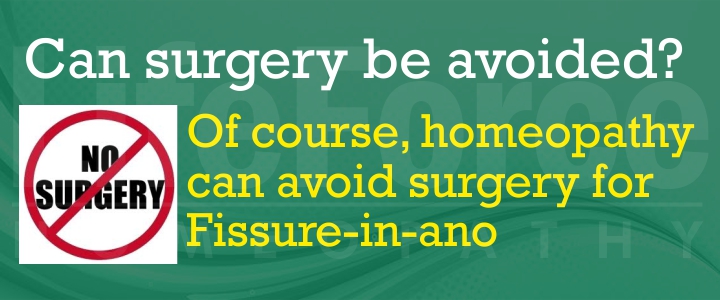
Conventional Treatment For Fissure-In-Ano:
- Creams or ointments containing painkillers, such as NSAIDs (non-steroidal anti-inflammatory drugs) or corticosteroids, are used to relieve the pain.
- Ointments, such as Glyceryl trinitrate ointment and Calcium channel blocker ointment, may relax the anal sphincter muscles and promote healing.
- Medicine to relieve constipation: Medicines like bran, Ispagol husk, Sterculia, etc. are used to soften the stool. The patients usually get used to or habitual to these medicines.
- In some cases, antibiotic creams are used to control the local infection.
Our Experience In Treating Fissure-In-Ano At Life Force:

As per our experience at Life Force, laxatives and painkillers cannot cure fissures. Fissure-in-ano finds an excellent and long-lasting treatment with homeopathy. It is possible to avoid surgery in many cases of Fissure-in-ano if homeopathic treatment is administered at the proper time. At Life Force, we have treated and documented different cases of Fissure-in-ano and, in over 80% of cases, homeopathic treatment has proved quite effective. More importantly, homeopathic medicines help to reduce the habitual tendency for constipation and this prevents the recurrence of the Fissure-in-ano. Homeopathic medicines are completely safe and free from side effects when administered by a qualified and expert homeopath.
Here is a description of a few of the commonly used homeopathic medicines for anal fissure:
- Aesculus hippocastanum: Aesculus hippocastanum, familiar as horse chestnut, is one of the common homeopathy medicines for piles and fissures. It is often indicated in cases where anal fissures are associated with piles and other venous congestion issues like varicose veins in the rectum. The patient complained of shooting, and sharp pain in the rectum while and after passing the stool. The pain radiates from the anal region up towards the rectum. Patients experience burning pain after bowel movements which may last for a few minutes to hours. The hallmark of prescribing Aesculus hippocastanum is an anal fissure associated with backache, typically characterized by a dull aching pain in the lower back. The consistency of the stool is dry and hard which makes the complaints of anal fissure worse. There is the sensation of fullness and heaviness in the rectum. Bleeding is not typically seen in Aesculus hippocastanum.
- Ratanhia: This remedy is beneficial when there is intense pain and burning after passing the stool. The patient describes pain, as a sensation of sharp sticks or broken glass in the rectum. The long-drawn-out discomfort is characteristic of this remedy; the pain experienced with Ratanhia is long-lasting and extends for prolonged hours after bowel movements. There is a feeling of incomplete evacuation and an urge to pass the stool. The complaints get worse by touching the affected area. This remedy is suitable for individuals who are restless and irritable because of the persistent pain and discomfort.
- Nitric acidum: Nitric acidum is primarily indicated when the anal fissures are deep and for excruciating sharp, cutting pains while passing the stool and remains for some time after passing the stool. The patient exhibits marked sensitivity, the affected area is quite sensitive and the slightest touch or pressure exacerbates the pain. It is indicated often when anal fissures are accompanied by profuse bright red bleeding. The stools are hard, dry, knotty, and difficult to pass with offensive smell.
- Hamamelis: This remedy is beneficial for anal fissures when there is dark and profuse bleeding. It is primarily indicated with a pain characterized by a pulsating or throbbing type. The patients do experience weakness when the bleeding is quite excessive. The patient prefers to use cold compresses to help alleviate the pain and discomfort.
- Sulphur: The burning pain in the anus is often described by patients as flame or as if hot poker is present inside the anus. Sulphur is considered when the pain associated gets worse after washing. The pain is worse during passing the stool and while walking. Sulphur patients do experience intense itching and irritation around the anus, itching further leads to scratching which further exacerbates the complaints. Individuals needing Sulphur feel mentally and physically exhausted due to itching and discomfort.
As with any homeopathic remedy, the selection of homeopathic remedies should be based on a comprehensive evaluation of the individual's symptoms and overall health by a qualified homeopathic practitioner. This ensures the most appropriate remedy is chosen for effective and holistic treatment.
Related Disease:
- Hemorrhoids
- Anal fistula
- Rectal Ulcer
- Anorectal Abscess
- Proctitis
- Pilonidal cyst
- Pruritis Ani
- Rectal prolapse
- Constipation.